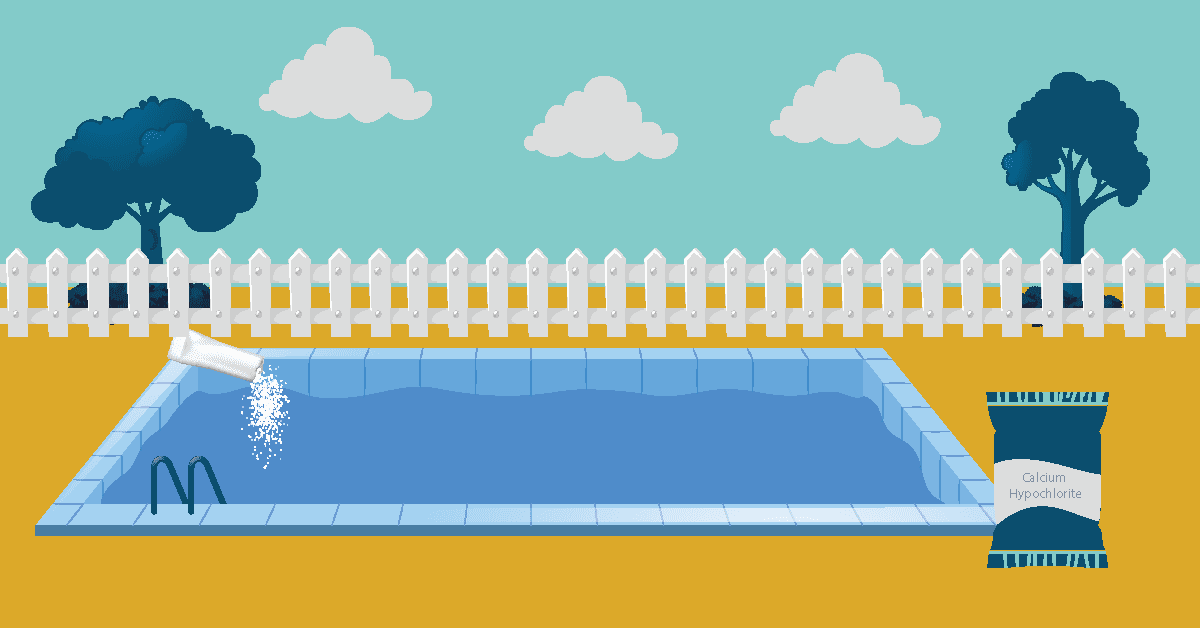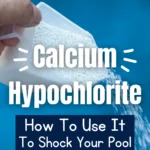If you are a pool owner, you are likely quite aware of the importance of shocking your pool. There is quite a bit to learn when it comes to pool maintenance. Having to balance chemicals, keep track of opening and closing procedures, and combat issues like algae or bacteria in the water. It can take years to get the pool maintenance regime down.
One great way to make sure that your pool water stays clean and sanitized is to use a pool shock. The best pool shock to use is Calcium Hypochlorite. If you use this shock properly, your pool will be safe and clean to swim in. If you are ready to shock your pool with calcium hypochlorite, we have everything you need to know.
What Is Calcium Hypochlorite?
Calcium hypochlorite is a combination of calcium oxide and chlorine gas. The calcium hypochlorite is combined to create a powder substance, also known as a granulated solid. Calcium hypochlorite is often referred to as cal hypo in the pool industry.
Many pool owners are unaware that there are different types of pool shock to choose from when cleaning your water. The cal hypo pool shock has been around for more than fifty years, and it has become the trusted way to shock a pool.
Calcium hypochlorite is a very strong base, and it can sometimes impact the pH level in your pool. Cal hypo is priced well, and it has a decently long shelf life as well. You won’t have any trouble finding the right environment to store the calcium hypochlorite shock.
Overall, everything about this product makes it one of the best options when it comes time to treat your pool water with a shock.
What Is Calcium Hypochlorite Used for in a Swimming Pool?
Although pool owners and professionals throw the word shock around quite a bit, not everyone knows exactly what pool shock does to swimming pools. Many assume that it is just a large blast of chlorine to really get the water clean after a large swim load or an algae issue.
Although it is partially true that Calcium Hpyophlorite is used to give the pool a large dose of chlorine, there is a bit more to it than that.
Cal Hypo has unstabilized chlorine as the active ingredient, and it has quite a bit of it. Most brands will contain about 65 to 75 percent chlorine. The concentration is quite high, and it will have the power necessary to take care of bacteria growing in your pool. Shock products find bacteria and destroy their cell structure so that people can swim in the pool yet again.
The cal hypo is unstabilized, so although your pool may have a very high chlorine level after its initial application, the sun will burn off the excess chlorine rather quickly. Therefore the pool is safe to swim in about eight to twelve hours.
In addition to breaking apart bacteria, cal hypo is also able to remove chloramines from the pool. Chloramines are actually quite gross. Essentially this is where chlorine will trap itself with dead skin cells or human organic matter of any kind. Unfortunately, chlorine is not all that good at getting these things out of the pool, and the contaminants just hang out in your water.
To remove these chloramines completely, you need a shock that will break them apart and allow the filter pump to do its job. Shocking the pool is not something that pool owners can avoid; it needs to completed.
Is Calcium Hypochlorite the Best Chemical for Shocking a Pool?
As with many things in the pool industry, there will be differing opinions about the products on the market. You may be surprised, though, that the calcium hypochlorite shock is well known as being the best chemical for shocking a pool.
The relatively fair price, the easy storage, and the effectiveness and treating any problem in the pool put the cal hypo ahead of other options on the market. If you learn how to use the cal hypo chemical properly, it may be the only shock you ever need. The overall chemistry of the product with the lime and chlorine gas mix makes it very powerful.
When Does a Pool Need to Be Shocked With Calcium Hypochlorite?
There are a few different times when it makes sense to use calcium hypochlorite to shock your pool. Most pool owners will stay on a regular schedule with shock, where they will use the product every few weeks simply to ensure the water is extremely clean. Here are a few other times that you will need to use cal hypo in your pool.
Bad Storm
When you have a large rain, the water chemistry is going to get thrown off. Testing the pool water after the rain, you may find that chlorine, calcium hardness, pH even cyanuric acid levels could all be off. Even though the rain may not have provided tons of water to the pool, it is enough to impact the pool chemicals.
It’s a good idea to shock your pool after a bad storm. The compound will ensure that your pool’s water chemistry can get back to its original levels. Some pool owners will run outside and put liquid bleach in the pool when it starts raining. It’s completely acceptable just to wait until the storm is over and shock the pool that night. Although algae and bacteria production happens fast, you won’t have to rush like that.
High Swim Load
Did you just have a family reunion at your house? Was it your ten year old’s birthday party?
IF you have recently had a large number of people swimming in your pool, you should shock it. High swim loads result in more chloramines and higher bacteria levels in your pool. Although putting a few extra chlorine tablets in your pool can help, it doesn’t have the same concentration of chlorine that pool shock does. Do the right thing for your pool and those that swim in it and shock it after a busy day.
Water Level Change
Sometimes we lose gallons of water in our pool because of an issue with a filter or pump. Other times we can gain quite a bit of water from a storm or hurricane. Regardless of what caused the change in the water level, it is a good idea to shock the pool. Think of the shock as a bit of a reset to get the pool functioning and clean yet again.
Specific Incident
As pool owners, we know that unfortunately, some incidents can happen in the pool. If someone has an accident in your pool, you need to shock it. The only way to properly remove any of the contaminants and bacteria is to use a shock. Calcium hypochlorite is a perfect choice because of its strength and relative ease of use.
What Are the Benefits of Using Calcium Hypochlorite?
Calcium hypochlorite is a great product to use to shock your pool and get it to a safe level for swimming and enjoyment. Calcium hypochlorite is easy to use, and you can store it for many years without it losing any of its effectiveness.
In addition, countries worldwide will use small amounts of calcium hypochlorite to clean the drinking water for their residents. Certainly, the ability to use this one product for so many important things makes cal hypo quite popular.
Luckily, even with how effective Calcium hypochlorite is, it will not be all that expensive. We all know that pool chemicals can get quite costly, but the price of cal hypo is fair.
Are There Any Negatives to Putting Calcium Hypochlorite in a Pool?
There are two negatives associated with putting calcium hypochlorite in a pool. The first is that you may notice the water is a bit cloudy just after application. This is no reason to panic; within a little while, the pool water should clear up just fine with the filter running. This is just part of the granular calcium hypochlorite starting to break down.
Secondly, you need to make sure you have a good place to store the calcium hypochlorite. Although this product has a long shelf life, it cannot be exposed to heat or moisture of any kind. Once it has been exposed, it will no longer work to treat your pool water effectively.
How to Use Calcium Hypochlorite to Safely Shock a Pool
Now that you have the basic understanding of why cal hypo is the smart choice for safely shocking your pool. We have to look at the best process for completing this task. You won’t have to spend all that much time or energy; the process is quite simple.
Step 1: Gather Supplies and Do Your Math
When you shock your pool, you are going to need a large container and access to water. In addition, you should wear a mask when you are working with the product so that you don’t inhale anything that hurts your lungs.
When calcium hypochlorite is used safely in the pool, it should not be dangerous. Still, some people experience eye irritation and lung irritation when using it. Safety equipment is sometimes something that all pool owners should have readily available.
In addition to getting your supplies ready, you will also need to calculate how much shock you need in your pool. The calculations are not all that difficult if you know how many gallons of water are in your pool. Most cal hypo products will tell you how much to use based on a 10,000-gallon increment.
Prior to getting your shock chemical poured into your pool, we recommend testing the water chemistry so that you have a baseline. When you are finished with these steps, you can move to the next part of the process.
Step 2: Mix Shock
The pool shock or calcium hypochlorite usually comes in a granulated powder-type compound. This makes the item quite a bit easier to work with. Remember that when working with shock, you are going to be dealing with high chlorine levels. It’s essential to mix your shock in a bucket of pool water before putting it in your pool.
Take a bucket, usually about a five-gallon bucket, and fill it 3/4 of the way with pool water. Then add in one bag of calcium hypochlorite. Once the bag is in, you can then move to the next step. Make sure that you only put one bag at a time into the bucket. Large pools may need three or four bags of shock to get the pool clean enough.
Step 3: Add Shock Around the Pool
Once your bucket is filled with shock water, you can then walk around the perimeter of your pool and evenly distribute the shock. You will do this each time until you have put the proper amount of shock into the pool. Remember that the solutions to your pool chemistry and water issues will only happen if you use the proper amount of calcium hypochlorite.
Step 4: Run Filter
Once your shock is in the pool, you will want to run your filter for at least twelve hours. If you don’t run it, the water won’t be properly treated. We recommend running it for a full 24 hours if they have that ability.
Remember that you should always put pool shock in the water at night. Since this is an unstabilized form of chlorine, it will burn up rather quickly by the sun. Avoid this by shocking at the right time.
Step 5: Test Before Returning to Swim
Prior to everyone jumping back into the pool, you want to make sure you check the chlorine level. The available chlorine and free chlorine are important to check. You won’t want people to jump in the pool and find out that the pool water is a bit too strong for them to enjoy.
A general rule of thumb to follow is that you should not swim for the first twelve hours after a pool was shocked. You may want to wait a bit longer for younger kids that are more prone to swallowing water when they swim.
How Much Calcium Hypochlorite is Needed per Gallon of Water?
Calcium hypochlorite is sometimes used as a way to clean drinking water. This is a completely different process and requires a specific product with a lower chlorine concentration. However, when you go through this process with an approved drinking water clarifier, you will use about a teaspoon for every two gallons of water.
When working with a pool, you will notice that it is quite a bit more water, and a teaspoon of calcium hypochlorite will not cut it. Therefore you will need a one-pound bag for every 10,000 gallons of pool water. This is why it’s so important to know the size of your pool before using any chemicals.
What Does Calcium Hypochlorite Do to a Pool’s pH?
Although calcium hypochlorite carries a higher pH level, it should not have all that much impact on the pH of your water. Although it is smart to check the pH levels both before and after you shock the pool, the pH level of calcium hypochlorite will do more to maintain the current level than to change the pool’s pH level.
Is Calcium Hypochlorite Dangerous?
Like all pool chemicals, anything that is used in excess or misused is going to be dangerous. The chlorine levels in cal hypo are extremely high. Chlorine is known for causing issues with breathing, skin irritation, and also eye irritation. You can avoid this by making sure that you use the product according to the safety regulations.
We also recommend storing the cal hypo products in a safe location far away from children and pets. In addition, always check the pool water before jumping in after a shock. Although the chemical compounds will have started to break down, they can still become irritants.
Can Calcium Hypochlorite Be Used as a Disinfectant or for Cleaning?
You can use calcium hypochlorite as a way to clean drinking water, but you will have to be careful how you use the product. If you are using the typical pool shock variety, you will only need a very small amount applied to a large fifty-five-gallon drum of water.
However, if you purchase a specific drinking water clarifier, you can follow those directions exactly.
Should I Buy Granular or Tablet Calcium Hypochlorite?
It is best to use granular calcium hypochlorite when it is available to you. We find the granular to be more effective than the tablet form, and it is easier to store and work with. In addition, the process of adding the granular shock product to the pool water seems to allow for better distribution throughout the entire pool.
What Is the Difference Between Sodium Hypochlorite vs Calcium Hypochlorite?
Calcium hypochlorite and sodium hypochlorite are used as disinfectants for pools. However, the cal hypo products are also going to contain calcium. If your pool has a calcium hardness level issue, you may want to consider using sodium hypochlorite.
In addition, the sodium hypochlorite does not contain quite as much chlorine. Therefore the product is cheaper but also not quite as effective. The difference between the two products is significant enough to do your research and make sure you choose the proper kind.
Should I Use Calcium Hypochlorite to Shock My Pool?
Calcium hypochlorite is a great choice when you need to shock your pool. It has everything necessary to get a pool safe to swim in, and it is relatively easy to work with and apply. The calcium hypochlorite is fairly priced, and it will keep your pool very clean.
The thing that most pool owners struggle with is when to shock the pool. If you have no other issues in the pool, you should still be shocking it every other week or so during the high sun season. Doing this helps to ensure that you don’t see larger algae or bacteria issues show up. Overall, calcium hypochlorite is a product that you will want to have on hand as a pool owner.

For over 15 years, Sean Moore has been sharing his love and enthusiasm for swimming pools and hot tubs with everyone he knows. His goal is to help everyday people DIY their maintenance to save money by teaching how to properly take care of your equipment, safely and correctly balance chemicals, and extend the life of your water oasis.


